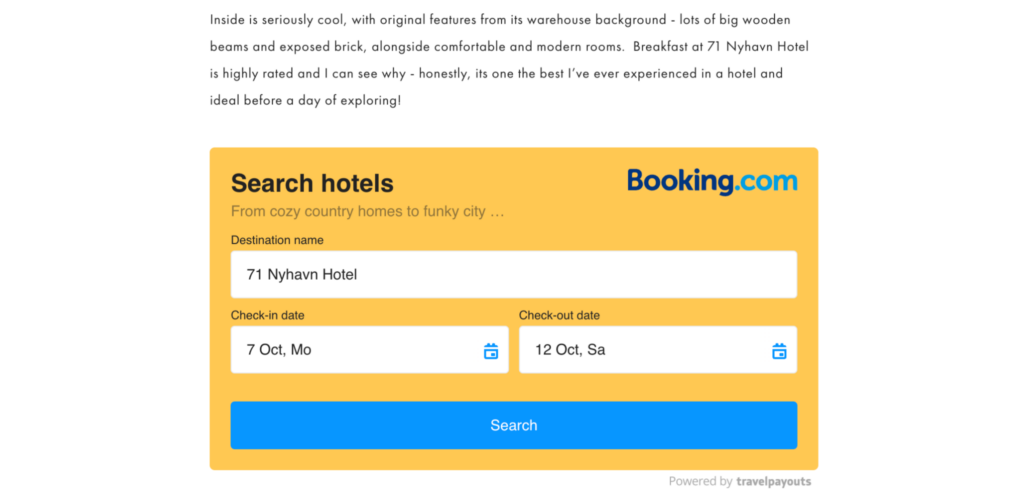Conversion isn’t just Snoop Dogg becoming Rastafarian.
It’s at the heart of affiliate marketing, telling you in a nutshell how successful you are at promoting brands. Are you getting plenty of organic? That’s great, but if you don’t hone your conversion game, you’re not making the most of that traffic.
This article is for those who want to boost their conversion. You’ll learn why every blogger should be tracking at least three conversion rates, how to analyze them, how to increase them, and how Travelpayouts can help.
Reminder: what is a conversion rate?
Remember, your conversion rate tells you how often visitors do what you’re hoping they’ll do.

This is online marketing 101. But if you’re only calculating conversion from a zoomed-out perspective – say, purchases out of total number of visitors – you’re missing a lot of useful information. We recommend tracking at least three different conversion rates:
- Views-to-clicks
- Views-to-bookings/purchases
- Clicks-to-bookings/purchases
Let’s say you’re promoting a brand that offers eSIMs to travelers. You write a blog post that contains a partner link. 1,000 people view the post, and 50 click the link. Then your views-to-clicks rate is:

Clicks are fine and good, but what about purchases? After all, you’re not earning anything unless your audience is actually buying eSIMs. Let’s say 10 readers end up buying after clicking the link. Then you can calculate your views-to-purchases rate, which represents the entire funnel:

And your clicks-to-purchases rate is 10/50, or 20%.
How to compare and analyze conversion rates
Tracking and comparing these three conversion rates can tell you which parts of your funnel can be improved.
In the example above, readers who click the link are pretty likely to make a purchase, but not many people are clicking in the first place. Why is that? Maybe you didn’t explain why they should be interested in an eSIM, or maybe you need to branch out from bare links to more advanced tools, like widgets. Just look at how much they spice up a page:

Or maybe you have a problem elsewhere in the funnel: say, plenty of people are clicking the link, but few are making purchases. This might mean your sales pitch is good, but users are giving up on the brand’s slow-to-load website. (Loading time seems to be an important factor in conversion.) In that case, consider looking for a comparable affiliate program on Travelpayouts.
Conversion rates are also a great metric for comparing different programs. If you’re promoting both Viator and GetYourGuide, conversion can tell you which appeals to your audience more, and you can focus your efforts on that one.
A/B testing to compare conversion rates
However, it’s not quite as simple as pulling up a couple of numbers and making a quick decision. If you want to know which of two programs (or affiliate tools – say, links vs. widgets) is more effective, you need to do a proper A/B test.
The point of A/B testing is to isolate the factor you’re studying. If you’re comparing a long read containing a Viator partner link and a short post all about GetYourGuide, you won’t be able to draw very good conclusions. Did the Viator link get fewer clicks because your audience wasn’t interested, or because they didn’t read far enough to see the link?
Enter the A/B test: you create two versions of the same post featuring each of the two brands, then compare the versions’ performance over a certain time period.
Google Analytics’ experiments framework is a great tool for splitting your audience and studying the results. And if you want to learn more about A/B testing, check out this step-by-step guide.
5 factors affecting conversion rates
First off, here’s something that definitely doesn’t affect conversion: whether you work with a brand directly or through an affiliate network like Travelpayouts. Using a network can streamline your workflow, but otherwise, this is a behind-the-scenes detail your audience never sees.
So what does have an effect? Here are a few concrete factors to pay attention to.
- Blog design. A smooth user experience is crucial. Even if you have great content ideas, a messy or hard-to-navigate blog can torpedo your conversion.
- Content quality. Your content should prove that you’re a professional. Make sure it’s useful for readers, responds directly to user intent, and looks or sounds good.
- Calls to action (CTAs). Is your aim to have readers join a mailing list? Make a booking? Create a short, clear CTA that encourages them to do exactly that, and incorporate links in a clean, visually attractive way – “Sign up today and get daily updates to your inbox” or “Book your tropical vacation!”
- Use of affiliate tools. Sometimes a bare link doesn’t attract enough attention, and you need to get fancy, or even schmancy. Travelpayouts provides various tools to help encourage conversion, and we’ve even prepared a free guide to using them like a pro.
- Targeted traffic. Are you sure your readers are ready to make bookings or purchases? Or do they just want to read about traveling? If it’s the latter, you may need to work to attract a different kind of reader into your funnel. This could mean adjusting the focus of your blog or advertising on different platforms.
5 tips to increase your conversion rates
Lastly, a few conversion-boosting guidelines based on the experience of our most successful partners.
- Tailor your content to your audience. Your content should address your audience’s specific travel needs and interests. Not sure what those are? Talk to your readers, experiment, run some polls on social media.
- Tailor your affiliate programs, too. Similarly, the brands you promote should be aligned with your blog’s niche and your audience’s interests. If they’re cat people, don’t try to sell them discounted stays at dog hotels. (Yep, that’s a thing.)
- Give authentic recommendations. Promote travel services using your personal experiences or thorough research. For instance, if you’ve ever been in a situation abroad where an eSIM would have saved your… skin, then talk about it. Users will trust your recommendations more if they see that you believe in them.
- Place links and widgets strategically: Your goal is to make affiliate tools prominent, but not obnoxious – obvious, but not OBVIOUS. It’s an art.
- Track and optimize: As you experiment, data will tell you what works and what doesn’t. Use analytics tools to identify top-performing topics and approaches and add more of them to the mix.
Go forth and optimize!
Now you should have some ideas for ways to improve your conversion. More advanced techniques include doing in-depth user research to find out exactly what your readers want and looking at traffic analytics for your website. This can help you answer questions like these: How much of each article do people usually read? Do posts that include pictures of you tend to generate better conversion?
Remember, success won’t come overnight. But by getting to know your audience and applying these tips consistently, you can almost certainly expect to see higher conversion.





